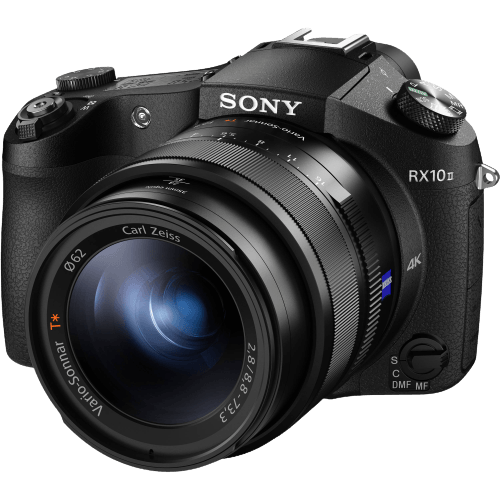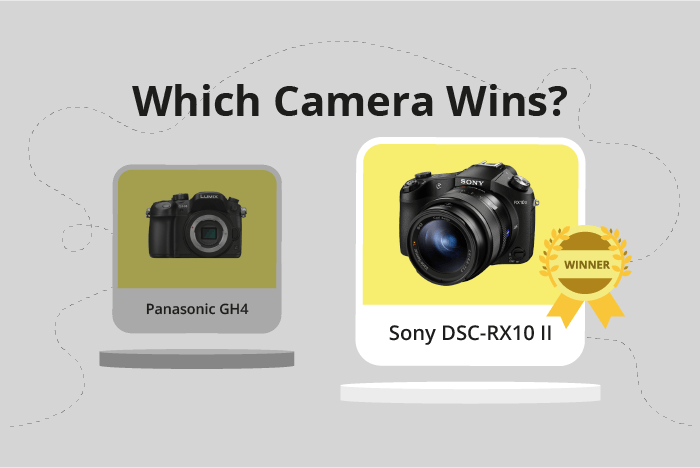Panasonic Lumix DMC-GH4 vs Sony Cyber-shot DSC-RX10 II Comparison
Panasonic Lumix DMC-GH4

Sony Cyber-shot DSC-RX10 II

The Sony Cyber-shot DSC-RX10 II narrowly wins against the Panasonic Lumix DMC-GH4 with a score of 59/100 compared to the latter’s 58/100. Both cameras were released in 2014 and 2015, respectively, and share similar dimensions. However, the GH4 is lighter, weighing 560g, while the RX10 II weighs 813g.
The GH4 has the advantage of being a mirrorless camera, which offers more flexibility with lenses, while the RX10 II is a bridge camera. However, the RX10 II is more affordable, with a launch price of $1,299 compared to the GH4’s $1,700.
Considering the specifications, the Sony RX10 II is a better choice for those seeking a more budget-friendly option, while the Panasonic GH4 is ideal for those who prioritize a lighter camera with interchangeable lenses.
Panasonic Lumix DMC-GH4 vs Sony Cyber-shot DSC-RX10 II Overview and Optics
The winner of our optics comparison is the Sony Cyber-shot DSC-RX10 II with a score of 64/100, while the Panasonic Lumix DMC-GH4 scored 52/100. Both cameras share some common specifications, such as having a CMOS sensor type and offering high shooting speeds, with the GH4 at 12 fps and the RX10 II at 14 fps.
The Sony RX10 II outperforms the GH4 in several aspects. It has a higher megapixel count at 20 compared to the GH4’s 16, allowing for better image resolution. The RX10 II also has a more advanced image processor, the Bionz X, which contributes to faster and more efficient image processing. Additionally, the RX10 II features image stabilization, providing steadier shots and reducing the chances of blurry images. The aspect ratio of 3:2 in the RX10 II is more suitable for printing photos.
On the other hand, the Panasonic GH4 has some advantages over the RX10 II. Its Micro Four Thirds sensor size is larger than the RX10 II’s 1″ sensor, which leads to better image quality and low-light performance. The GH4 also has a higher DXOMARK score for its sensor at 74, compared to the RX10 II’s 70, indicating better overall sensor performance. The GH4’s lens mount is Micro 4/3, allowing for a variety of lenses to be used, while the RX10 II has a fixed lens mount, limiting its versatility.
Taking all these factors into account, the Sony RX10 II is the superior camera in terms of optics, with better resolution, image stabilization, and a more advanced image processor. However, the Panasonic GH4 is not without its merits, offering a larger sensor size, better sensor performance, and greater lens versatility.
Panasonic Lumix DMC-GH4 vs Sony Cyber-shot DSC-RX10 II Video Performance
The Sony Cyber-shot DSC-RX10 II outperforms the Panasonic Lumix DMC-GH4 in video capabilities with a score of 77/100 compared to the GH4’s 70/100. Both cameras share the ability to record 4K video, ensuring high-quality footage for users. However, there are significant differences between the two models that contribute to the disparity in their scores.
The Panasonic Lumix DMC-GH4 has a maximum video resolution of 4096 x 2160, which is slightly higher than the Sony DSC-RX10 II’s 3840 x 2160. The GH4 also has built-in time-lapse functionality, offering creative options for videographers. However, the camera is limited to a maximum video frame rate of 24fps, which may not be suitable for capturing fast-moving subjects or producing smooth slow-motion footage.
In contrast, the Sony DSC-RX10 II boasts a remarkable maximum video frame rate of 120fps, allowing for detailed slow-motion capture and exceptional versatility in various shooting scenarios. The absence of built-in time-lapse functionality is a drawback, but this can be remedied with external software or accessories.
Taking these factors into account, the Sony Cyber-shot DSC-RX10 II emerges as the superior choice for video capabilities due to its impressive frame rate, despite the slightly lower video resolution and lack of time-lapse functionality. The Panasonic Lumix DMC-GH4 remains a viable option for those who prioritize time-lapse features and a marginally higher video resolution, but its lower frame rate limits its overall appeal in comparison to the Sony DSC-RX10 II.
Panasonic Lumix DMC-GH4 vs Sony Cyber-shot DSC-RX10 II Features and Benefits
The Panasonic Lumix DMC-GH4 excels in features with a score of 70/100, while the Sony Cyber-shot DSC-RX10 II trails behind with a score of 57/100. Both cameras share common specifications such as a 3-inch screen size, the absence of GPS, and the presence of WIFI connectivity.
The Lumix DMC-GH4 outperforms the Cyber-shot DSC-RX10 II in several aspects. Firstly, it has a touchscreen, which makes it more user-friendly and convenient to use. Additionally, the GH4 features a flip screen, allowing for more flexible shooting angles and easier self-portraits.
On the other hand, the Cyber-shot DSC-RX10 II has a higher screen resolution of 1,228,800 dots compared to the 1,036,000 dots of the Lumix DMC-GH4. This results in a sharper and more detailed display. The RX10 II also has Bluetooth connectivity, which the GH4 lacks, making it easier to connect with other devices for transferring files and remote control.
Considering the various features, the Panasonic Lumix DMC-GH4 is the superior camera due to its touchscreen and flip screen capabilities. These features make it more versatile and user-friendly. However, the Sony Cyber-shot DSC-RX10 II still holds its ground with a higher screen resolution and Bluetooth connectivity. Ultimately, the choice between these two cameras depends on the user’s preferences and priorities in terms of features and connectivity options.
Panasonic Lumix DMC-GH4 vs Sony Cyber-shot DSC-RX10 II Storage and Battery
The Panasonic Lumix DMC-GH4 outperforms the Sony Cyber-shot DSC-RX10 II in storage and battery with a score of 60/100 compared to 24/100. Both cameras accept SD, SDHC, and SDXC memory cards, but the GH4 has two memory card slots while the RX10 II only has one. Additionally, the RX10 II accepts Memory Stick Duo, Pro Duo, and Pro-HG Duo cards.
The GH4’s battery life lasts for 500 shots, whereas the RX10 II’s battery life is limited to 400 shots. The GH4 uses a DMW-BLF19 battery type, while the RX10 II uses an NP-FW50 battery type. Neither camera supports USB charging.
The GH4 wins in both storage capacity and battery life, making it a more reliable choice for longer shooting sessions. The RX10 II, however, offers more memory card compatibility with the addition of Memory Stick options. Considering these factors, the GH4 is the better option for users prioritizing storage and battery life, while the RX10 II may appeal to those with a preference for Memory Stick compatibility.
Panasonic Lumix DMC-GH4 vs Sony Cyber-shot DSC-RX10 II – Our Verdict
Are you still undecided about which camera is right for you? Have a look at these popular comparisons that feature the Panasonic Lumix DMC-GH4 or the Sony Cyber-shot DSC-RX10 II:

